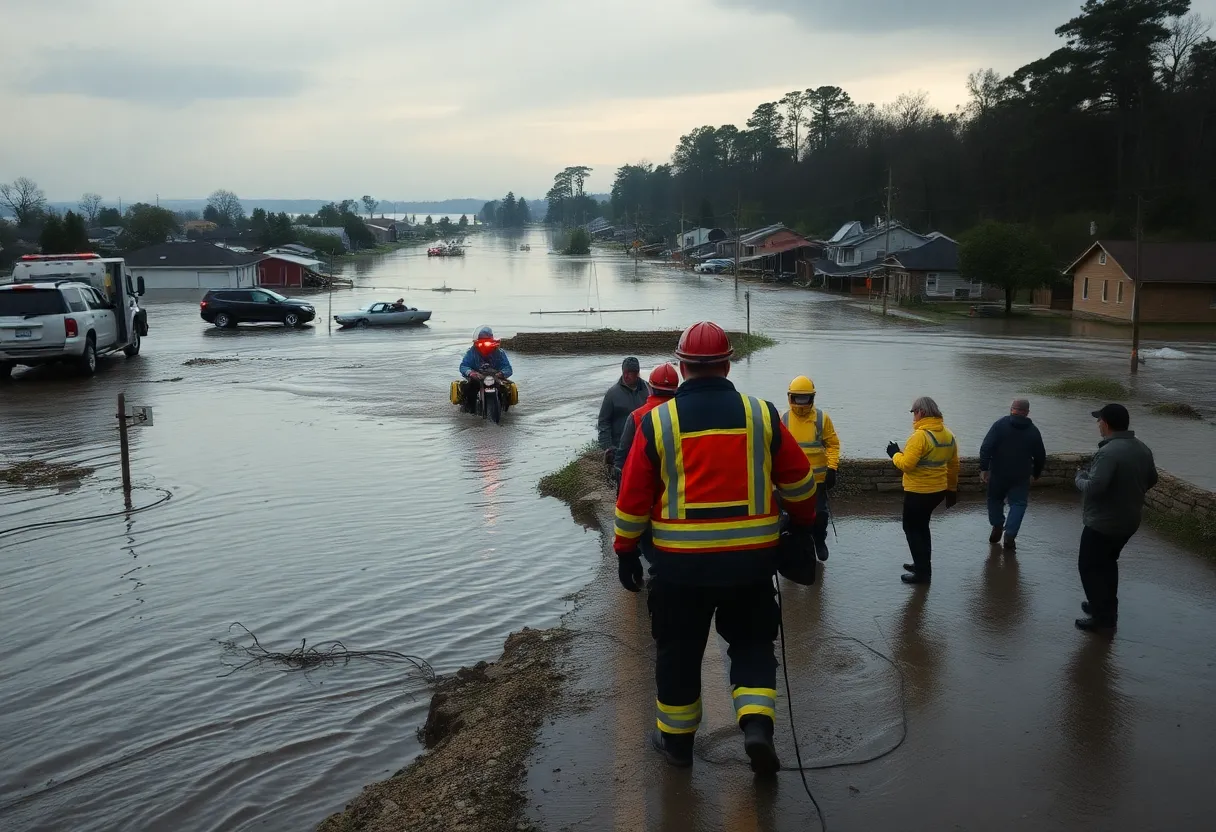News Summary
Kerr County officials are under fire following a disastrous response to significant flooding that resulted in nearly 100 fatalities and over 160 missing persons. The Integrated Public Alert and Warning System (IPAWS), crucial for timely emergency notifications, was not utilized effectively, causing significant delays in alerting residents. The Guadalupe River reached alarming levels, and local officials’ slow responses have sparked outrage and calls for accountability. As discussions about improving emergency preparedness gain momentum, the county must address its communication failures to safeguard residents in future crises.
Kerr County’s Emergency Alert System Under Fire After Deadly Flooding
In a shocking turn of events, Kerr County officials are facing criticism for their handling of an emergency alert system during catastrophic flooding that took place on July 4. The floods have tragically resulted in nearly 100 deaths and left over 160 individuals missing.
Record Flooding on the Guadalupe River
The Guadalupe River hit record heights, rising more than 30 feet in certain areas, particularly around Hunt, Texas, where numerous campers were present at the time. This alarming rise was exacerbated by a lack of timely communication from local officials, leaving many residents unprepared for the dangers ahead.
Emergency Alert System Not Utilized
Despite the availability of the Integrated Public Alert and Warning System (IPAWS), known for its effectiveness in turning cellphones into blaring alarms, local officials did not activate this crucial notification system either before or during the flooding. This decision raises serious questions about the emergency preparedness of Kerr County’s response team.
Delayed Notifications Spark Outrage
A review of the emergency notifications reveals a concerning timeline. The National Weather Service sent out its first flash flood warning through IPAWS at 1:14 a.m. on July 4, yet officials in Kerr County did not react promptly to these critical warnings. It wasn’t until later—hours after the flood had peaked—that some residents received alerts, with some notifications reaching them as late as 10:55 a.m.
Experts Weigh In on the Implications
Experts have emphasized that had the IPAWS alerts been activated, lives could have potentially been saved. Residents are more inclined to take warnings seriously when they come from recognized local authorities, adding to the weight of the criticisms directed at county officials.
A Call for Action and Accountability
Kerr County officials had successfully activated IPAWS alerts on two previous occasions, indicating a thorough understanding of the system. Yet, no immediate action was taken when it mattered most. Following scrutiny of the situation, county emergency management coordinator had suggested a more comprehensive flash flood warning system that included sirens for at-risk regions, but unfortunately, funding was not made available.
Communication Breakdowns Exacerbate the Crisis
The slow responses from local officials amid communications with the National Weather Service added to residents’ frustrations. Although the National Weather Service issued about 22 alerts advising residents to evacuate to higher ground, many people ignored these notifications, likely because they were used to receiving warnings for less serious weather events.
Rescue Operations Amidst Chaos
As floodwater raged, local emergency responders were challenged with multiple rescue incidents, including reports of children trapped and RVs swept away. Despite the growing chaos, it took until 5:31 a.m., well into the height of the flooding, for Kerr County officials to post an update on social media platforms.
Late Evacuation Orders Spark Further Criticism
The first evacuation order through IPAWS came nearly three days after the onset of flooding, on July 6. This delay has led to widespread calls for a thorough review of Kerr County’s emergency response strategies. Many locals voiced their frustrations about receiving insufficient and lackluster alerts that did not convey the urgency of the situation.
Looking Ahead: The Need for Improved Preparedness
This disaster has ignited a broader conversation around disaster preparedness and response protocols, especially as severe weather events become increasingly common in the region, often referred to as “**Flash Flood Alley**.” Local officials have made public statements regarding their focus on rescue efforts and accountability but have been hesitant to delve into the specific failures of the alert system timeline.
As Kerr County assesses the fallout from this tragedy, it’s clear that improved communication and response measures are sorely needed to prevent future catastrophes and protect residents from imminent dangers.
Deeper Dive: News & Info About This Topic
- Washington Post: Kerr County’s Emergency Alert System Under Fire After Deadly Flooding
- NBC News: Texas Officials Give Answers on Kerr County’s Response
- KHOU: Expert Calls on Kerr County Flood Alert Delays
- Click 2 Houston: First Responder Calls for Alert During Kerr County Flood
- Wikipedia: Emergency Alert System
- Google Search: Kerr County Flooding

Author: STAFF HERE PETERSBURG WRITER
The ST PETERSBURG STAFF WRITER represents the experienced team at HEREStPetersburg.com, your go-to source for actionable local news and information in St Petersburg, Pinellas County, and beyond. Specializing in "news you can use," we cover essential topics like product reviews for personal and business needs, local business directories, politics, real estate trends, neighborhood insights, and state news affecting the area—with deep expertise drawn from years of dedicated reporting and strong community input, including local press releases and business updates. We deliver top reporting on high-value events such as Grand Prix of St. Petersburg, Localtopia, and SHINE Mural Festival. Our coverage extends to key organizations like the St. Petersburg Area Chamber of Commerce and St. Pete Downtown Partnership, plus leading businesses in finance, manufacturing, and healthcare that power the local economy such as Raymond James Financial, Jabil, and Bayfront Health St. Petersburg. As part of the broader HERE network, including HEREJacksonville.com, HEREOrlando.com, HERETallahassee.com, and HERETampa.com, we provide comprehensive, credible insights into Florida's dynamic landscape.





